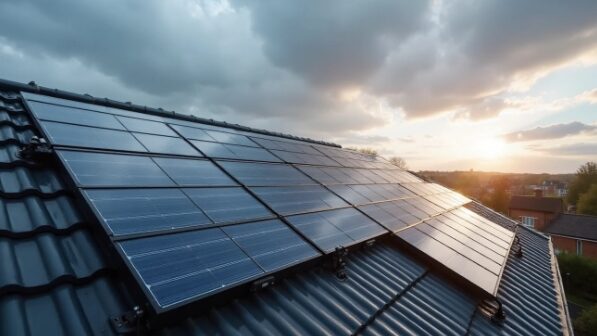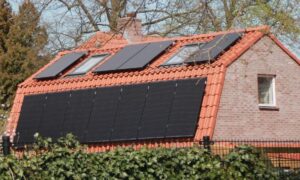Do solar panels work on cloudy days? This question often comes up when UK homeowners think about solar energy. Modern solar panels can still produce 10-25% of their rated capacity during heavily overcast conditions, despite the UK’s notoriously cloudy skies.
A 4kW solar system in Scotland—the UK’s cloudiest region—can generate between 2,600-3,400 kWh annually. This output covers 40-50% of an average household’s electricity needs. Solar panel efficiency on cloudy days varies based on several factors, but they work effectively even in cloudy weather. Scientists have found that partially cloudy days can produce higher electricity outputs than bright, cloudless ones through the “Edge-of-Cloud Effect.” While direct sunlight yields the best results, UK’s cloudy weather doesn’t stop solar panels from working efficiently.
In this piece, we’ll look at real data that shows solar panel performance in different UK regions. You’ll learn about technologies that boost cloudy weather performance and get practical tips to maximize your solar investment whatever the weather brings.
How solar panels generate power without direct sunlight
People often ask about solar panels and their performance on overcast days. Solar panels don’t need bright, direct sunshine to generate electricity.
Daylight vs. sunlight: What matters more
Daylight powers solar panels more than direct sunlight. The common phrase “daylight, not sunlight” explains this concept. This difference is significant because usable light remains abundant even on cloudy days. Clouds filter the sun’s rays instead of completely blocking them. Solar panels can harness diffused sunlight that scatters through the atmosphere, clouds, and other obstacles.
The photovoltaic effect explained
The photovoltaic effect drives solar energy generation. Solar panels use photovoltaic (PV) cells made from semiconductor materials, usually silicon. Sunlight’s photons hit these cells and knock electrons loose from atoms to create an electric current. The cells absorb these photons, which make electrons move and generate electricity.
The p-n junction collects light-generated carriers that push electrons toward the n-type side and holes to the p-type side. This movement creates voltage across the cell. Both direct and indirect sunlight carry photons that power this process.
How much energy is produced on cloudy days
Solar panels keep working in cloudy conditions but produce less electricity:
- Light cloud cover reduces output by about 24% compared to sunny days
- Heavy clouds decrease production by 67%
- A typical cloudy day yields 10-25% of normal output
A 350-watt solar panel in the UK generates about 0.55 kWh on mildly overcast days and 0.24 kWh during heavy cloud cover. This compares to 0.72 kWh on average days.
The “Edge-of-Cloud Effect” can boost production on partially cloudy days as sunlight magnifies when it breaks through clouds. Cold temperatures also improve panel efficiency and help offset shorter winter daylight hours.
UK solar performance: What the real data shows
UK’s real-life data shows how solar panels work in our typically cloudy weather. The actual performance numbers tell an interesting story about solar power’s success across Britain.
Regional differences in solar output
Solar potential varies a lot across the UK. Southern England’s solar panels produce the most energy and give the best returns on investment. Scotland’s panels generate over 850 kWh per square meter yearly, despite its famously cloudy skies.
The East of England shines with monthly surface solar radiation averaging 240.85 W/m² and solar systems working at 18.1% capacity – making it the second most efficient region nationwide. Cornwall takes the lead in solar adoption. Nearly 10% of Cornwall’s homes (over 23,000) have solar panels installed because they get more sunlight than any other UK region.
Annual output estimates in cloudy regions
A typical 4kW solar system in the UK produces about 3,400 kWh of electricity each year. The output changes with seasons. Winter months see production drop to about one-eighth of summer levels.
Cloudy days still allow panels to produce 10-25% of their rated capacity. British solar panels work at 85% of their ideal output potential. Solar capacity keeps growing year after year. The UK hit a new record on April 1, 2025, generating 12.2GW of solar power.
Case study: Manchester vs. London
Two major cities help us understand how solar performs in different parts of the UK. London’s 4.4kWp system generates about 549.43kWh in July but drops to 164.96kWh in January. Manchester’s larger 6.5kWp system produces around 756.42kWh in May but only 184.02kWh in December.
Manchester gets less sunshine than the UK average, yet solar panels prove highly effective there. A typical Manchester home with solar panels cuts electricity bills by about 65% and saves £505 yearly. The city now has 42,131 homes with MCS-certified solar panels, which makes up about 3.45% of all Manchester homes.
Technology that improves cloudy weather performance
Solar panel performance has substantially improved in less-than-ideal weather conditions due to technological advances. Homeowners can now control solar energy that works even under Britain’s notoriously gray skies thanks to several breakthroughs.
Monocrystalline vs. polycrystalline panels
The choice between panel types makes a huge difference for UK residents who face frequent overcast days. Monocrystalline solar panels work better than other varieties in cloudy conditions mainly because of their high-purity silicon structure. These panels reach impressive efficiency rates of 15-24%, which beats polycrystalline panels’ 14-16% efficiency.
Monocrystalline panels excel in cloudy weather because each solar cell has a single silicon crystal instead of multiple fragments. This allows electrons to move freely and generate electricity even with minimal sunlight. As one expert notes, “Even on a very cloudy or rainy day, you’ll get some electricity… but on real cloudy days, you might only get half as much electricity as you would on a sunny day”.
Bifacial panels and reflected light
Bifacial solar panels stand out as one of the most promising technologies for cloudy climates. These panels capture sunlight from both front and rear surfaces and can increase energy production by 5-30% compared to traditional panels.
These panels excel at collecting scattered and reflected light – exactly what you see on overcast days. They can boost power generation by up to 27% under optimal conditions with solar trackers. Their performance gets better with higher tilt angles since more light reaches the rear side.
Anti-reflective coatings and low-light optimization
Silicon’s high reflectance (approximately 35%) reduces panel efficiency substantially. Anti-reflective coatings help solve this by cutting reflection losses by 2-3% and increasing light transmittance to 94-95%.
Most commercial panels now include these coatings, typically made of titanium oxide or silicon nitride. The coatings minimize reflection while maximizing light absorption, which helps especially during overcast conditions. These AR-coated panels turn more diffused sunlight into usable electricity when direct sunlight is scarce.
How to get the most from solar panels in cloudy climates
Solar panels in the UK need the right setup and maintenance to work at their best, especially with frequent overcast skies. A few smart tweaks can make a big difference in power generation, even when the weather isn’t perfect.
Panel tilt and orientation tips
The way panels face makes a huge difference in cloudy weather. Your panels should point true south in the Northern Hemisphere to get the most sunlight. The best tilt matches your location’s latitude, which runs between 30-45 degrees for most UK homes. This setup lets rain wash the panels naturally and captures sunlight effectively all year. The panels need at least a 10° tilt to clean themselves properly.
Avoiding shade and obstructions
Shade can cut panel output by 50-80%, so managing it matters a lot. A full site check by professionals will spot problems like trees, buildings, or satellite dishes. Regular trimming of nearby plants helps because branches can really hurt performance. Some spots can’t avoid shade – that’s when bypass diodes, microinverters, or DC optimizers come in handy to reduce power loss.
Cleaning and maintenance best practices
Your panels need cleaning every 12-18 months to stay efficient. Rain helps keep them clean, but regular upkeep is still important. Here’s what to use:
- Soft brushes or microfiber cloths
- Mild dish soap with warm water
- Low-pressure water (never use pressure washers)
Safety should be your top priority – switch off the system before cleaning and don’t risk getting on the roof if you’re unsure about access.
Using battery storage to store excess energy
Batteries play a vital role in cloudy climates by saving extra power from sunny spells for darker days. Lithium-ion batteries work better than lead-acid ones, with 90-95% efficiency compared to 70-80%. These systems can use more of their capacity (80-90% vs. 50-60%) and last longer (10-15 years vs. 3-7 years). A good storage system helps smooth out power production that would otherwise go up and down with cloud cover.
Conclusion
Data and technological advances prove that solar panels work on cloudy days in the UK. Their efficiency drops during overcast conditions, but modern panels still generate 10-25% of their rated capacity. These numbers add up by a lot throughout the year.
The UK’s notorious cloud cover worries many homeowners, but facts tell a different story. A standard 4kW system produces between 2,600-3,400 kWh yearly, whatever the regional weather patterns might be. This output covers 40-50% of an average household’s electricity needs, making solar panels a smart investment across Britain.
Modern technology keeps improving cloudy-day performance. Monocrystalline panels, bifacial designs, and anti-reflective coatings work together to boost efficiency in less-than-ideal weather. These advances help panels capture diffused light and generate electricity even without direct sunlight.
Smart installation choices make a huge difference to maximize production. Your system will perform better with proper panel orientation, tilt angles that match your latitude, and regular upkeep. Battery storage adds more value by letting you use excess energy from sunny days when clouds roll in.
Solar energy in the UK shows more promise than most people think. Our gray skies haven’t stopped solar adoption from growing nationwide. Cornwall leads the way with about 10% of homes having rooftop panels. Manchester residents who install solar save around £505 each year.
Solar power offers UK homeowners a practical and eco-friendly energy solution, whatever the local weather brings. The right equipment and proper planning help your solar investment pay off well – rain or shine.
FAQs
Q1. How effective are solar panels on cloudy days in the UK? Solar panels can still generate electricity on cloudy days, typically producing 10-25% of their normal output. While less efficient than on sunny days, they remain effective due to their ability to convert visible light, not just direct sunlight, into electricity.
Q2. What factors influence solar panel performance in cloudy weather? Several factors affect solar panel performance in cloudy conditions, including panel type (monocrystalline panels perform better), technology (such as anti-reflective coatings), panel orientation, and geographical location within the UK.
Q3. How much electricity can a typical solar system generate annually in the UK? A standard 4kW solar system in the UK can generate approximately 3,400 kWh of electricity annually. This output typically covers 40-50% of an average household’s electricity needs, despite variations in weather conditions.
Q4. What maintenance is required for solar panels in the UK climate? Regular maintenance includes cleaning panels every 12-18 months using soft brushes or microfiber cloths with mild soap and warm water. It’s also important to keep surrounding vegetation trimmed to avoid shading and ensure the system is turned off before cleaning.
Q5. How can UK homeowners maximize their solar panel efficiency? To maximize efficiency, ensure panels face true south with a tilt angle between 30-45 degrees. Avoid shade from nearby objects, consider using battery storage to store excess energy, and opt for technologies like bifacial panels that can increase energy production by 5-30% compared to traditional panels.



































